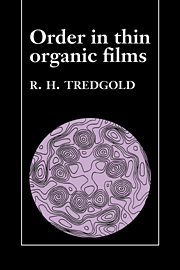Book contents
5 - More complex structures formed by the Langmuir–Blodgett technique
Published online by Cambridge University Press: 21 September 2009
Summary
Introduction
In this chapter we turn to the study of LB films formed from polymers and LB films consisting of alternate layers of two different amphiphiles. In principle, of course, it would be possible to superimpose successive layers of three or more distinct amphiphiles but little has been done in this direction. However, a few examples of more complex alternating structures will be considered.
Polymer LB films naturally divide into the following categories.
Systems in which a multilayer structure is formed from molecules containing one or more double bonds and in which polymerisation is subsequently initiated by irradiation by γ-rays, ultraviolet light or an electron beam.
Systems similar to the above but in which the constituent monomers contain the diacetylene group.
Multilayers formed from polymers bearing both hydrophilic and hydrophobic side groups which are spread as polymers at the air/water interface and are subsequently deposited on a substrate by the LB technique.
Rigid rod polymers which have both hydrophilic and hydrophobic characteristics and which are capable of residing with the rod axis horizontal at the air/water interface and which can be deposited on a solid substrate by the LB technique.
Post-formed polymers made from monomers containing one or more double bonds
Studies of polymerisation at the air/water interface have been made repeatedly over the years and an account of early work in this field is given by Gaines. Here the discussion will be largely confined to polymerisation carried out after deposition.
- Type
- Chapter
- Information
- Order in Thin Organic Films , pp. 82 - 115Publisher: Cambridge University PressPrint publication year: 1994



